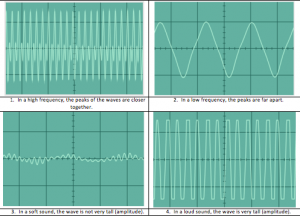The Sounds of Science
3 Min Read • STEAM
Being a musician and a STEAM teacher, I bet you’ll never guess what my favorite unit of study is… yep, you got it – the science of sound. Every since I first laid eyes on an oscilloscope during my college days, I was hooked. Back then, those wondrous machines were about as tall as I am (5’8″), and they resembled an old fashioned T.V. screen – complete with tubes. Oh, did I mention all the gadgets? Lots and LOTS of buttons, switches, and dials! That little, circular screen transported me into another world during our Wednesday night lab session, where we got to measure the frequency of pitches and the amplitude of vibrations. By the end of the semester, we were almost able to identify instruments and notes by the shape and structure of the wave form alone! My lab partner and I would sometimes sneak into the classroom early, conduct our experiment, and then erase all of our data just so we could do it all over again when the instructor arrived. A little nerdy? Absolutely!!
Thank goodness those huge devices are a thing of the past. I’d say technology has made some pretty big advancements over the years. That being said, I’d like to share some ways for you to pump up the volume (pun intended) on your sound and science lessons.
Sound Advice
Recently, some of my team mates and I developed a wonderful unit to support the NGSS first grade performance expectations of Waves: Light and Sound. Although the lessons were filled with lots of great hands-on explorations using tuning forks, hand percussion, and a really great engineering design challenge where the kids had to build a device to stop the sound, we realized something was missing. Some of the most basic concepts of sound still weren’t being heard!
The students had a good grasp of what vibrations were, but they were having a more difficult time discerning between low/high pitch (frequency) and soft/loud volume (decibels or dB). Let’s take a moment to clarify a few terms before we continue:
Vibration – a periodic back and forth motion of an object
Frequency – the number of oscillations or cycles (the speed) of a wave per unit of time
Decibels – the volume of the wave as noted by the amplitude (height) of the sound wave
In other words, the speed of the wave = pitch (high/low) and the amplitude = volume (loud/soft). These were much more abstract concepts for almost all of the students to comprehend.
Seeing is Believing
I began to search to find a way for the students to clearly understand all 3 of these concepts. Hooray for modern technology! Did you know that dunking a well struck turning fork into a small cup of water while the iPad camera recorded in slo-motion, provides a concrete (and entertaining!) way to observe the effects of a vibrating object? My students wanted to watch that video over and. over… After further investigation , I also found many applications that became helpful in driving the concepts of frequency and decibels home all (literally) in the palm of your hands. Here is an online oscilloscope app you can try, as well as this iOS app, which happens to be a personal favorite of mine.
Seeing the difference in the sound waves made all the difference in the world for my kiddos, and I know it will for yours too. The great thing is, you don’t have to have a device for all of your students to use the apps. One device projected on a screen is enough for the whole class to benefit from. Below is a sample of four sound waves: high, low, soft, and loud using the online oscilloscope app.
Well, the verdict is still out on who had more fun with this unit, me or my students, but I’m willing to call it a draw. I highly recommend you give it a try with the added technology.
By the way, if you’re looking for more great ways to integrate music into your day, check out The Science of Sound and many more strategies! Enjoy!




